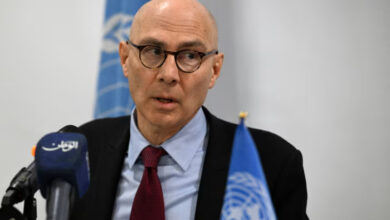
When 13-year-old Malika from a dusty village outside Cairo, Egypt turned 11, her mother took her to the doctor late at night. It was not until she saw the blood and heard the cries from the other girls that it dawned on her — she was about to undergo female genital mutilation (FGM).
Already a pricey operation, her family couldn't afford the extra 100 Egyptian pounds for the anaesthetic, so Malika was cut without it.
A horrific tale of pain and despair, but Malika's experience is far from extraordinary in her country, where the vast majority of women are cut.
More than 200 million girls and women alive today have undergone some form of female genital mutilation (FGM), also called female circumcision — with another 15 million young girls expected to undergo the process in the next decade, according to UNICEF.
With countries like Egypt cracking down on the ancient practice — often performed illegally by a non-medically trained local midwife called a Daya — parents are finding ways to get round the law.
Cut in secret
In Egypt, Dayas have been discouraged by the 2007 criminalization of FGM, which now comes with the threat of years in prison.
Instead, Egyptian doctors increasingly carry out the cut in secret in the early morning or late at night — charging the parents large amounts for the procedure.
"It's become increasingly medicalized and this is a change in trends in FGM in Egypt," says Germaine Haddad, a representative from the United Nations Population Fund (UNDPA) in Egypt.
In a 2015 survey carried out by the Egyptian Ministry of Health, an estimated 82 percent of FGMs on women up to the age of 19 were conducted by doctors or other medical personnel.
This represents a leap from the older age group upon whom skilled health workers had performed just under 40 percent of the cuts.
Haddad works with Doctors Against FGM, a campaign by the health ministry and UNDPA that aims to integrate awareness of FGM in the curriculum of the country's medical schools, where it will be taught as a harmful practice.
No safe way
While parents believe turning to a doctor is a safer option than a Daya, campaigners warn of the trend.
"This is not a medical practice whatsoever. Nobody should be doing it," Haddad says.
It also adds a sense of legitimacy.
"When you are in a poor, not very well educated community, the doctor is an educated person you look up to, who you consult. So if he is practicing FGM it definitely gives it legitimacy in the community which makes it harder to denounce," Haddad adds.
But there is "no safe way" to perform the risky procedure which can result in severe injuries to the patient, regardless of who holds the razor or surgical knife, says Ayan Sadek, a medical doctor and Upper Egypt programme manager at Plan International, who works to fight FGM.
"Some of the doctors don't know what to cut. It's not a medical procedure. The schools and colleges here don't teach students to do FGM."
Doctors learn from Dayas
Some doctors learn directly from the Dayas, who have no official medical training, he adds.
It's not just Egypt — other countries like Kenya and Nigera are experiencing similar shifts in trends, according to anti-FGM campaigning group 28 Too Many, who are about to launch a campaign on the issue of medicalization.
FGM is prevalent among both Muslims and Christians in Egypt. Most prevalent in 28 countries in Africa and some countries in Asia and the Middle East today, it harks back to Pharaonic times.
Across Africa, more than 90 million girls and women over the age of 10 are estimated to have undergone FGM, according to the UNDPA.
A violation of the human rights of girls and women, it can cause severe bleeding and other health issues, including cysts, infections, infertility and complications in childbirth, according to the World Health Organization.
The most common immediate complications are heavy bleeding and inflammation, Sadek says.
"This is very common in Egypt, and some of the girls die. The procedure may include cutting a lot of nerve endings and the complications are unpredictable.
Gender based violence
So why is it so hard to eradicate? Tradition and deeply entrenched social norms contribute to keeping it going, says Sadek.
"Parents do this because of social pressure from other families. The mother knows it's a harmful practice — she has suffered it too. Still [she feels that] not circumcising her daughter would bring shame on the family."
Ultimately, it's about gender inequality and controlling female sexuality, Sadek says.
"This is gender-based violence against girls."
"They believe that if they cut parts of her body, it means she will not ask for sex."
The role of the boys
The practice does appear to be in decline in Egypt, however, with recent figures from the National Council for Women suggesting that its prevalence among schoolgirls may be down to 54 percent across the country, Sadek says.
Organizations like Plan International run community theaters, which is an interactive way of raising awareness. They also include men in the dialogue.
"Engaging boys and young men is critical," says Sadek.
Slowly, attitudes are changing. "But still, we do face resistance," Sadek adds.
Some of the names of the girls, who told their story to Plan International's researchers, have been changed to protect their identities




